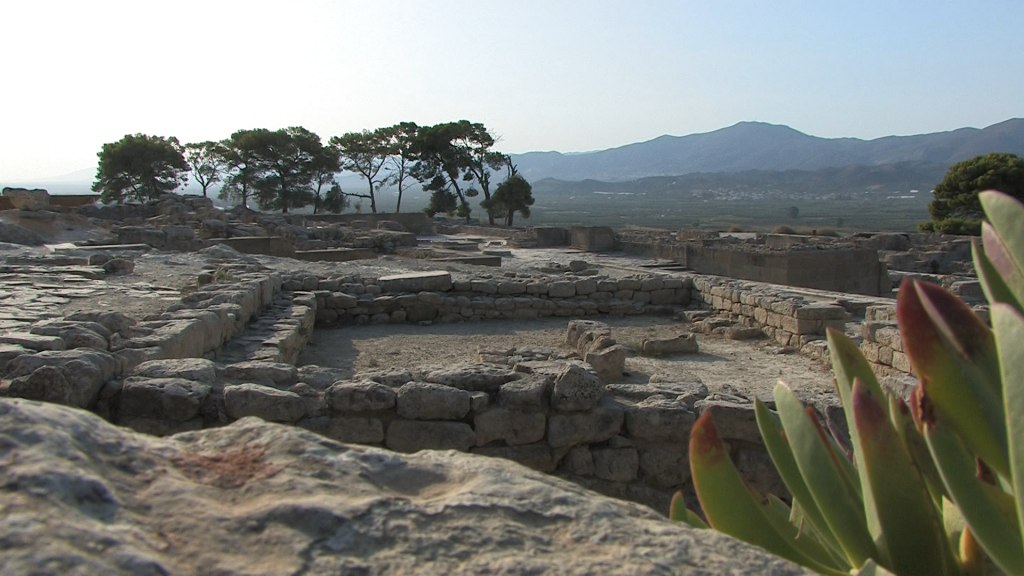Phaistos Minoan Palace, an awe-inspiring archaeological marvel nestled on the sun-drenched island of Crete, Greece, stands as a testament to the intricate ingenuity and cultural richness of a civilization that flourished over 4,000 years ago. This ancient palace, an epitome of Minoan architecture and sophistication, conjures images of a society that thrived within its walls, leaving behind a legacy that continues to captivate the modern world.

Phaistos, its name resonating with echoes of history, occupies a commanding hill overlooking the fertile Mesara plain. This vantage point provided not only strategic advantage but also a panoramic vista of the landscape—a vantage from which the inhabitants of the palace could oversee their realm. The ruins that stretch across the hillside are a symphony of stone, each fragment a note in the larger composition of the Minoan experience.
At the heart of this archaeological treasure trove lies the Phaistos Minoan Palace. Its grandeur speaks of a society that prized sophistication, aesthetics, and communal living. The palace’s layout, carefully orchestrated to intertwine open courtyards, stately chambers, and labyrinthine corridors, mirrors the intricate interplay of public and private spaces that defined Minoan architecture.
The Throne Room, a chamber of unparalleled significance within the palace, captures the essence of Minoan social structure. The alabaster throne, a symbol of authority and power, rests within a room adorned with vibrant frescoes. These intricate murals, capturing scenes of nature, rituals, and symbols, offer glimpses into the Minoan worldview—a world imbued with reverence for nature and spirituality.
The Phaistos Disc, a clay artifact covered in inscrutable symbols arranged in a spiral pattern, was discovered within the palace’s walls. This enigmatic object, often hailed as one of archaeology’s greatest mysteries, hints at the complexity of Minoan script and communication. Its role, purpose, and meaning continue to elude modern decipherment, leaving behind an air of intrigue that has persisted for centuries.
The palace is not a static structure; it’s a living testament to the ebb and flow of civilization. Over the centuries, as different hands and cultures left their imprint, the palace evolved. Additions, alterations, and adaptations bore witness to the ever-changing needs of the society that occupied its chambers.
Venturing beyond the palace’s main structure, one encounters the sprawling network of chambers, storerooms, and residential spaces. The meticulous planning of these spaces, designed to accommodate a wide range of activities, showcases the Minoans’ mastery of architectural design. The presence of grain storage facilities speaks of an agrarian economy that sustained the Minoan way of life.
Art, a central facet of Minoan culture, flourished within the palace’s confines. The murals that adorned the walls, many of which have been preserved and studied, provide insights into the society’s aesthetics, rituals, and values. Vivid depictions of animals, vegetation, and ceremonial scenes serve as a visual time capsule, offering a glimpse into the artistic tastes of the Minoans.
The palace’s significance extended beyond its architectural marvels. It was a hub of economic activity, where trade, industry, and administrative affairs converged. The Linear A script, another undeciphered form of Minoan writing, was found on various clay tablets, hinting at the intricate record-keeping and administrative functions that took place within the palace’s walls.
The Phaistos Minoan Palace was not merely a physical structure; it was the nucleus of a vibrant civilization that celebrated the arts, fostered communal living, and navigated the complexities of governance. It was a beacon of the Minoan way of life—a life that reveled in the beauty of nature, the pursuit of knowledge, and the expression of creativity.
As the sun sets over the palace’s ruins, casting long shadows upon the stones that bore witness to a civilization’s rise and fall, Phaistos Minoan Palace continues to weave its story. It transports us to an era when humans mastered the art of construction, harnessed the power of culture, and left their mark on the tapestry of time. In the whispers of the wind that rustle through its ancient corridors, we hear the echoes of a civilization that may have faded but whose legacy lives on, inspiring us to marvel at the remarkable achievements of the Minoans and their enduring impact on our understanding of history.